Except for the occasional car rumbling by and the unsettling hourly broadcast through loudspeakers across the island, Izena might as well be abandoned. We did not see a single soul on the island’s eponymous settlement, and the only signs of recent activity in the landmark Mekaru House are the neatly trimmed trees and a packaged mochi snack that expired last year.
The house is still owned by descendants of the uncle of Sho En, Izena’s favorite son whose dramatic rise from poor farmer to the king of the Okinawa-based Ryukyu Kingdom remains a source of pride for residents today. The island won’t be this quiet for long, our guesthouse owner tells us, as the King Sho En marathon would be taking place in a few days. But for now, we have the unbelievably pristine beaches all to ourselves.
Even though February is low season for Okinawa, it was the Lunar New Year holidays after all, and I wanted our yearly family vacation to take place as far away as the crowds as possible. I chose Izena, population 1,500, for its historical significance, unspoiled scenery and difficulty of access (2.5 hours bus ride from the prefectural capital of Naha plus a 55 minute ferry that only runs twice per day).
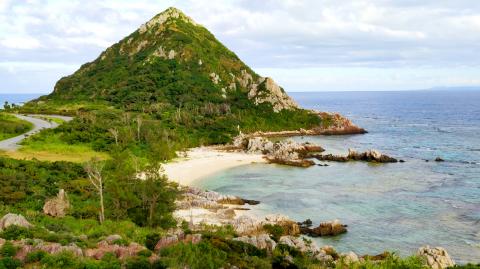
Photo: Han Cheung, Taipei Times
Our second destination, Yoron Island, is slightly larger at 20.8km square but much busier with a functioning downtown. The main draw is Yurigahama, a sand bar located about 1.5km off the coast that appears in different locations and sizes according to the season and tides, but there are also abundant diving and watersports opportunities as well as an unique language and culture that is slowly disappearing.
Both islands have plenty of guesthouses, but few are bookable online. Locals from both islands tell me that they rarely see foreigners — even in the summer — and I use my rusty Japanese to get by as even the tourism office staff in Yoron speak little English. For those lost in translation, Okinawa provides a free tourist interpretation hotline service in Chinese, English and Korean; and there’s always Google Translate.
BIRTHPLACE OF A KING
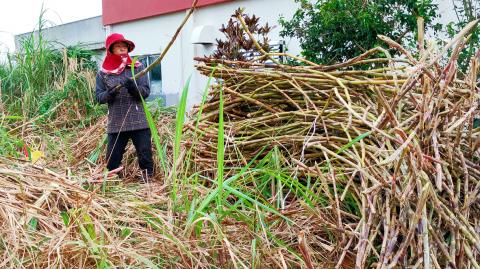
Photo: Han Cheung, Taipei Times
Most people flock to the Nago peninsula, located in the northern half of Okinawa, for its castle ruins and excellent Churaumi Aquarium, as well as the surrounding Ocean Expo Park. We find ourselves, however, in sleepy Nakijin village, which seems quiet enough that I wonder if it’s even necessary to mosey on to the even more remote Izena.
Nakijin village’s Unten Port is the only access point to Izena and its northern sister Iheya, and aside from us the only people waiting to board are Japanese dock workers dressed in neat light-blue and gray uniforms. Of course, the ferry is named after Sho En, adorned with a large decal of the king, still dressed as a peasant, pointing toward the sky and his destiny.
Legend has it that Sho En, originally known as Kanemaru, fled Izena after locals became resentful that his fields still had water while everyone else were suffering from drought. He arrived in Okinawa and eventually became an influential noble and statesman in King Sho Taikyu’s court. Sho Taikyu’s successor, Sho Toku, was said to be an unpopular ruler; after his death in 1469 the nobles orchestrated a coup and placed Kanemaru on the throne — although Kanemaru’s level of involvement is still disputed as some maintain that he played an active role in the usurpation.
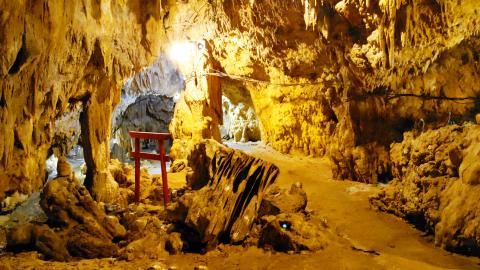
Photo: Han Cheung, Taipei Times
Kanemaru took on the new name of Sho En, and his descendants ruled the Ryukyu Kingdom for four centuries until Japan annexed it in 1879 and moved the royal family to Tokyo. The Sho family tomb sits at the foot of a hill on the southeast corner of the island and is still visited by members of the family each year as they traverse the Samuree Michi, an 2km ancient stone path connecting the Mekaru House and the tombs.
The port is eerily quiet as we disembark. There’s a sports complex that doesn’t look like it gets much use on one side, and car and bike rental shop next to a tiny homestyle restaurant that mostly caters to dock workers. The buildings quickly give way to sugarcane fields and small-scale farms as we make the 10-minute walk towards the nearest settlement of Nakada, the closest thing to a “town” on Izena. Coral reefs completely surround the island, blessing the beaches with crystal-clear, shallow waters that are surprisingly warm even in winter.
Our guesthouse, Marutomi (NT$1,500 per person including breakfast and dinner), is run by a family who also own the island’s only sushi and karaoke bar across the street. The rooms are quite cramped, but the owners’ warm hospitality and mouth watering home-cooked meals make the experience worth it. There’s a few Japanese tourists staying here on a fishing trip. A few blocks away from Marutomi is a park dedicated to Sho En that contains the remains of the house he was born in as well as a thatched hut structure called a kami asagi, which is used for Ryukuan religious rituals.
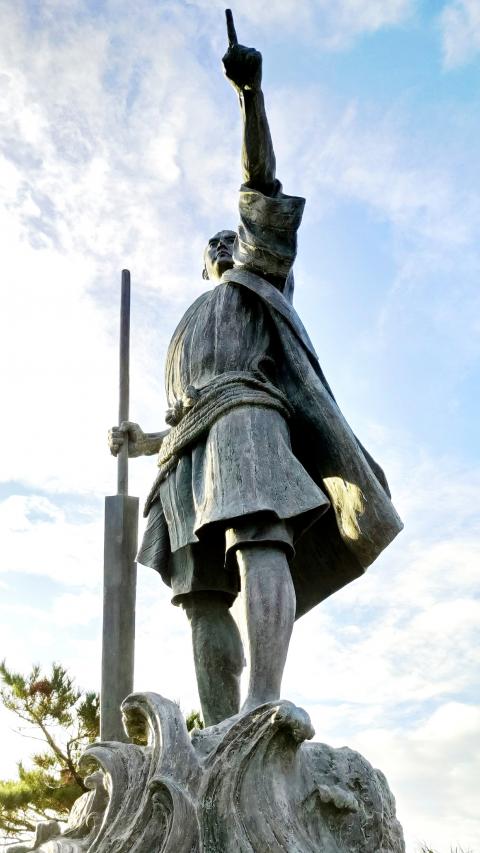
Photo: Han Cheung, Taipei Times
The entire island can be circled by bicycle in just over an hour, with the jagged rock formations of the southern coast the most scenic. Aside for a sugarcane processing plant and a few general stores, the western and northern parts are even more desolate as we pass by a boarded-up bath house and library and a large community center that looks like nobody has entered in years. Only the eerie hourly broadcasts, including the creepiest one at 6:30pm urging the island’s few schoolchildren to go home, punctuate the silence.
ELUSIVE SANDBAR
Yoron Island is not administratively part of Okinawa, instead belonging to Kagoshima Prefecture, but compared to Izena it is much easier to access from Naha via a five-hour direct ferry ride. Although just slightly larger than Izena, it boasts four times the population and has amenities such as taxis, buses, convenience stores and guesthouses that are bookable online. Still, don’t expect anyone to speak English here.
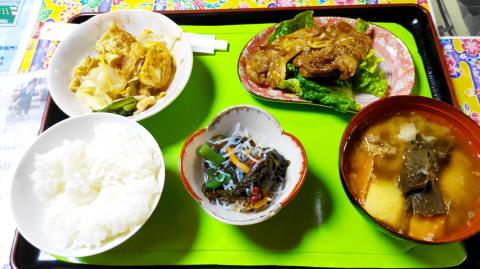
Photo: Han Cheung, Taipei Times
Yoron boasts a relatively upscale resort, but we go for cheap and friendly at the family-run Hoshizunaso (NT$2,500 per room including breakfast). The simple tatami rooms are clean and decent sized and while it’s a 20-minute car ride from the main port, it’s closer to the bulk of the attractions.
The guesthouse provides free pickup from the ferry. There are slightly more dining options around here, with a seaside open-air joint where I enjoyed a simple rice set with local mozuku seaweed, and Fukuya, a Japanese-Western fusion restaurant that makes use of local ingredients. Further down the road is an unassuming sushi “shack” where I had to rouse the owner from his sleep in his van. You’ll probably see more goats and cows than people, but the ones you do meet (usually sugar cane farmers) are extremely gregarious and will drop what they’re doing at the rare chance to chat with a foreign tourist.
It goes without saying that the beaches are crystalline and beyond gorgeous, but the highlight of the trip was a visit with Kiku Hidenori, who runs the Yoron Folk Village near our guesthouse. Kiku speaks basic English and eagerly shows visitors his reconstructed traditional houses, old wooden pillows and toys as well as a oxen-operated sugarcane crusher.
Kiku’s mother Chiyo is the coauthor of the only dictionary on Yoron’s distinct language, Yunnu Futuba, which is rarely spoken by people under the age of 40. Kiku himself has published a series of workbooks on the language and teaches it in the local elementary school, but it’s hard to stop the tide of switching to standard Japanese. The family are among the bastions of Yoron’s disappearing culture, as Kiku’s wife and mother claim to be the only people on the island left who still practice traditional weaving.
Other highlights include an atmospheric stalactite cave and a hilltop Shinto shrine and castle ruins that provide sweeping views of the mostly-flat agricultural island whose highest point is 97 meters above sea level. Otherwise, it’s just a joy to stroll through the fields and enjoy the tranquility of one of the more far-flung areas of Japan. Most tourists will likely be found at Ooganeku beach, where outfits offer diving, standup paddleboard and windsurfing experiences and enterprising boat owners take tourists out to the enigmatic Yurigahama sandbars for about NT$800 per head.
We pack into our guide Tome’s glass-bottomed boat as he deftly navigates the shallow waters, trying multiple times and finally succeeding in passing over a sea turtle. Yurigahama is not where Tome expected it to be, and when we finally locate it, it’s much smaller than the photos advertise due to it being winter. About a dozen of us cram onto the tiny speck of land and while there’s nothing to do but to take photos, it’s okay because it’s almost impossible to get a bad shot of this surreal paradise even with people blocking the view.
Okinawa seems like a giant continent when our ferry approaches the main port, and we feel like we’re in a hectic metropolis on the laid-back streets of Naha. There are numerous more commercialized and easily accessible islands to frolic on just around the corner, and few will ever make it out to Izena and Yoron. Perhaps it’s better that way, otherwise we wouldn’t have had a whole beach to ourselves.

In the next few months tough decisions will need to be made by the Taiwan People’s Party (TPP) and their pan-blue allies in the Chinese Nationalist Party (KMT). It will reveal just how real their alliance is with actual power at stake. Party founder Ko Wen-je (柯文哲) faced these tough questions, which we explored in part one of this series, “Ko Wen-je, the KMT’s prickly ally,” (Aug. 16, page 12). Ko was open to cooperation, but on his terms. He openly fretted about being “swallowed up” by the KMT, and was keenly aware of the experience of the People’s First Party

Aug. 25 to Aug. 31 Although Mr. Lin (林) had been married to his Japanese wife for a decade, their union was never legally recognized — and even their daughter was officially deemed illegitimate. During the first half of Japanese rule in Taiwan, only marriages between Japanese men and Taiwanese women were valid, unless the Taiwanese husband formally joined a Japanese household. In 1920, Lin took his frustrations directly to the Ministry of Home Affairs: “Since Japan took possession of Taiwan, we have obeyed the government’s directives and committed ourselves to breaking old Qing-era customs. Yet ... our marriages remain unrecognized,

Not long into Mistress Dispeller, a quietly jaw-dropping new documentary from director Elizabeth Lo, the film’s eponymous character lays out her thesis for ridding marriages of troublesome extra lovers. “When someone becomes a mistress,” she says, “it’s because they feel they don’t deserve complete love. She’s the one who needs our help the most.” Wang Zhenxi, a mistress dispeller based in north-central China’s Henan province, is one of a growing number of self-styled professionals who earn a living by intervening in people’s marriages — to “dispel” them of intruders. “I was looking for a love story set in China,” says Lo,

During the Metal Ages, prior to the arrival of the Dutch and Chinese, a great shift took place in indigenous material culture. Glass and agate beads, introduced after 400BC, completely replaced Taiwanese nephrite (jade) as the ornamental materials of choice, anthropologist Liu Jiun-Yu (劉俊昱) of the University of Washington wrote in a 2023 article. He added of the island’s modern indigenous peoples: “They are the descendants of prehistoric Formosans but have no nephrite-using cultures.” Moderns squint at that dynamic era of trade and cultural change through the mutually supporting lenses of later settler-colonialism and imperial power, which treated the indigenous as